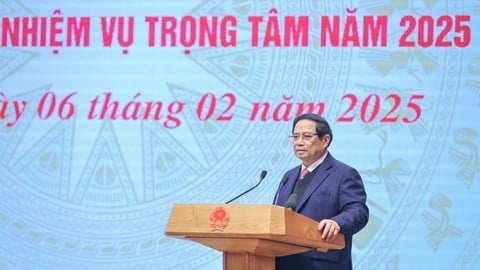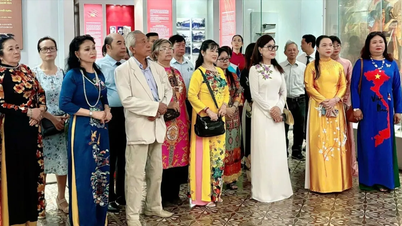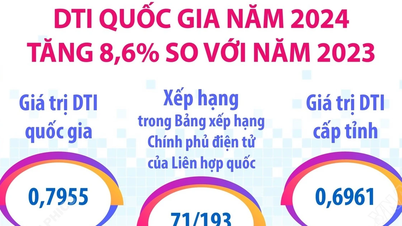On October 20, the Prime Minister signed Decision No. 2319/QD-TTg on the establishment of the National Steering Committee on Data. This is an important step from individual direction to unified coordination, promoting the construction and exploitation of national data infrastructure...
This shifts the focus of e- Government from “procedural digitization” to “data-based governance”. Data, therefore, is not only a professional tool, but also the foundation for the administrative apparatus to operate according to the principles of service, transparency and efficiency.

From data connectivity requirements to institutionalization steps
Over the past decade, the e-Government process in Vietnam has gone through two main phases: digitizing processes and creating core data infrastructure. Key databases such as population, business, land, insurance, health, and education data have been built, gradually creating a "digital backbone" for state administration. Along with that, the National Public Service Portal and electronic one-stop systems in ministries, branches, and localities have expanded rapidly, leading to a marked increase in the number of online applications and the rate of on-time settlement.
But that achievement only reflects the stage of "bringing procedures to the digital environment". To move to the stage of "Government operating by data" requires a strong enough institution to unify standards, remove sharing bottlenecks and ensure safety and privacy. Therefore, the establishment of the National Steering Committee on Data is meaningful as a national coordination mechanism, clarifying roles, responsibilities, and ways of connecting systems that are built in many phases, with many resources and at many different levels.
In reality, there is a lot of data but it is still fragmented, each industry has a "warehouse", each locality has a "platform", with different formats, conventions and management methods. Data sharing still largely depends on bilateral agreements or request processes, which is time-consuming. Therefore, people and businesses still have to repeatedly declare basic information when doing different procedures; state agencies have to manually compare, and operational decisions lack real-time updates.
Project 06 on the development and application of population data, electronic identification and authentication has created a technical breakthrough by connecting population data with many specialized databases, cleaning, synchronizing, and attaching each record to a unique identification code. However, technology is only half the battle. For data to truly “flow” continuously, be useful and safe, there needs to be an institutional coordination axis that unifies shared data standards, sharing rules, access rights hierarchy, and risk control mechanisms.

Vietnam has a “very high” e-Government Development Index.
The shift in thinking from “administrative request and grant” to “administrative service based on data” also requires appropriate legal guarantees. The Personal Data Protection Law 2025, effective from January 1, 2026, establishes a framework of rights, obligations and responsibilities in the collection, processing, storage and sharing of personal data; sets out the principles of minimization, clear purposes, informed consent, accountability and sanctions for violations.
Once the legal framework for privacy is established, trust in data connection and sharing between government agencies and between the public and private sectors will be stronger. That trust is an indispensable condition for moving towards a unified data architecture, where “declaration once, use many times” is no longer a slogan, but an operating principle.
Towards Digital Government
The priority of the next phase is to connect social security data, the group of data that directly affects people's lives. When social insurance, health insurance, education, and labor data are synchronized with population data, every change in residence, employment, study, and health will be reflected quickly; payment, confirmation, transfer, and school transfer procedures will therefore be simplified.
Migrant workers can purchase and renew health insurance and receive services at their actual place of residence; children who move with their families to temporary residence have more favorable conditions for school admission when the system recognizes them by citizen identification codes; policy review and prevention of policy abuse are carried out through an automatic matching mechanism instead of manual verification. When health, insurance and education data are connected with population data, the social policy-making process becomes more accurate, updated and humane, ensuring that “no one is left behind” in the digital transformation process.
More broadly, data connectivity not only serves public administration but also creates a foundation for smart social services. Population management, transportation, healthcare, education and employment systems, when connected, will help forecast population needs, plan schools, hospitals, urban infrastructure and human resources. This is the factor that turns data from a “static resource” into a “living energy source”, nurturing the development of digital government.
For data to truly become the operating platform of e-Government, the national data infrastructure must be built synchronously on three pillars. First, a common data standard so that all systems, whether of ministries, branches or localities, can "talk" to each other, ensuring that data is exchanged, understood and used consistently. Next is a sharing and security standard, clearly defining the scope of access, authorization mechanism, exploitation logs and security responsibilities in each stage of operation. And last but not least, is a standard for data human resources, a team of data architects, integration engineers, analysts and information security administrators with enough capacity to maintain, protect and effectively exploit the entire infrastructure.
At the local level, the gap in operational capacity is still evident. Therefore, on-site training mechanisms, sharing of experts in clusters, competitive recruitment of “data civil servant” positions and public-private partnerships in training and technology transfer are solutions that need to be considered early, along with evaluation criteria based on the level of data exploitation in public service performance. Technical infrastructure, from data centers, integration and sharing platforms, cloud computing, dedicated transmission lines to backup and disaster recovery mechanisms, must be invested in accordance with safety standards, readiness and scalability.
Many units still maintain the local server model, which is both costly and difficult to ensure security. Moving to a shared platform, exploiting national data centers, applying microservice architecture and API standards will be more economical, flexible and secure.
On that infrastructure, data analysis systems serving operations, from population forecasting to school and hospital planning; real-time traffic data to reorganize routes; labor market analysis to support retraining and job connections, have the conditions to be promoted. The role of the National Steering Committee on Data in this picture is clear: Not to replace the technique, but to do the right "coordinating hand", master planning, unify standards, monitor interconnection progress, organize independent inspection of data quality and the level of exploitation in public service performance.
Once the coordination mechanism is in place, the legal framework for privacy protection has been established, and the universal electronic identification platform has been established, the task of the entire system is to persevere through the “long journey” of standardization, interconnection, and exploitation, with strict data discipline, strong human resources, and secure infrastructure. The ultimate goal remains unchanged: Putting data in the right place, serving people better, helping to make more accurate decisions, and making the apparatus more streamlined and transparent.
From the foundation of national data, e-Government enters a new stage of development, where data becomes the “central nervous system” of the entire administrative apparatus. The next step of that process must be to turn data into a serving force, so that each policy and each public service accurately reflects practical needs and aims at people’s satisfaction – the highest measure of a serving administration.
(To be continued)
Source: https://baovanhoa.vn/nhip-song-so/bai-1-nen-mong-cho-chinh-phu-so-177671.html


![[Photo] Hue: Inside the kitchen that donates thousands of meals a day to people in flooded areas](https://vphoto.vietnam.vn/thumb/1200x675/vietnam/resource/IMAGE/2025/10/29/1761738508516_bepcomhue-jpg.webp)

![[Photo] Human love in the flood in Hue](https://vphoto.vietnam.vn/thumb/1200x675/vietnam/resource/IMAGE/2025/10/29/1761740905727_4125427122470875256-2-jpg.webp)
![[Photo] Prime Minister Pham Minh Chinh chaired a meeting to discuss solutions to overcome the consequences of floods in the central provinces.](https://vphoto.vietnam.vn/thumb/1200x675/vietnam/resource/IMAGE/2025/10/29/1761716305524_dsc-7735-jpg.webp)

![[Photo] Prime Minister Pham Minh Chinh chaired a meeting to evaluate the operation of the two-level local government model.](https://vphoto.vietnam.vn/thumb/1200x675/vietnam/resource/IMAGE/2025/10/29/1761751710674_dsc-7999-jpg.webp)












































































![[Live] Concert Ha Long 2025: "Heritage Spirit - Brightening the Future"](https://vphoto.vietnam.vn/thumb/402x226/vietnam/resource/IMAGE/2025/10/29/1761743605124_g-anh-sang-am-thanh-hoanh-trang-cua-chuong-trinh-mang-den-trai-nghiem-dang-nho-cho-du-khach-22450328-17617424836781829598445-93-0-733-1024-crop-1761742492749383512980.jpeg)




























Comment (0)